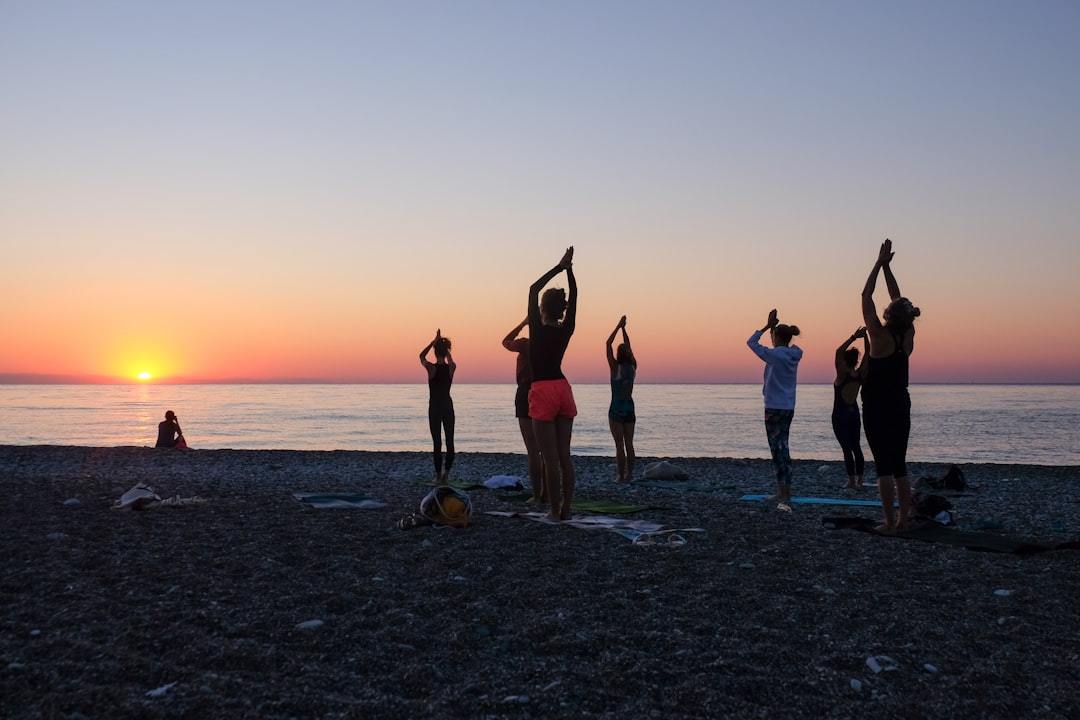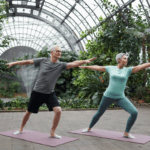Coming Soon: E-book about Kundalini Yoga - Sign up here to be among the first to get it!
Ever stood on a mountain peak, greeted the rising sun, and felt its golden rays fill you with warmth and vitality? That’s Sun salutation for you – an ancient yoga sequence that mirrors this awe-inspiring experience. This empowering flow of poses is not just about stretching your body; it’s also about awakening your spirit.
You’re probably wondering, what makes Sun Salutation so special?
Well, imagine starting each day by saluting the sun – symbolizing light, hope, and new beginnings. Through a series of postures from Mountain Pose to Downward-Facing Dog, it’s like choreographing a dance with breath as your rhythm.
Intrigued yet?
I bet you’re wondering! But the real kicker is figuring out how to nail these poses without straining our bodies or tipping over. Keep an eye out as we explore further.
Table of Contents:
- Understanding Sun Salutation
- The Art of Sun Salutation Sequence A
- Exploring Sun Salutation Sequence B
- Yoga Styles and Their Take on Sun Salutation
- Common Mistakes and Corrections in Sun Salutation
- Adapting Sun Salutation for Different Skill Levels
- Safety Precautions While Practicing Sun Salutation
- FAQs in Relation to Sun Salutation
- Conclusion
Understanding Sun Salutation
The sun salutation, or surya namaskar, is a fundamental yoga sequence often used as a warm-up at the start of practice. But its roots run deeper, with origins in ancient Indian traditions where it was performed to honor the sun.
Sun salutations can be modified for different skill levels making them accessible to all practitioners. They’re also flexible enough that many yoga teachers base whole classes around them.
Components of Sun Salutation
A typical sun salutation involves a series of twelve poses seamlessly flowing into one another synchronized with your breath. The cycle begins and ends in Mountain Pose (Tadasana), embodying stillness amidst movement.
Moving from Mountain Pose, you raise your arms overhead (Urdhva Hastasana) before folding forward (Uttanasana). You then create length along your spine by lifting halfway up into Ardha Uttanasana and move towards Plank pose followed by lowering down onto your belly – Chaturanga Dandasana.
The sequence progresses through Upward-Facing Dog (Urdhva Mukha Svanasana) and Downward-Facing Dog (Adho Mukha Svanasana), returning back to standing position through various transitional movements.
For more details on each step, this illustrated guide provides an excellent resource: Sun Salutation Illustrated Step-by-Step Instructions.
Breathwork in Sun Salutations
In every pose within the sun salutation sequence, breath plays an integral role – it’s what gives life to our practice. Typically each movement aligns with either an inhale or exhale, cultivating a meditative flow and fostering mind-body connection.
For example, as you lift your arms overhead in Urdhva Hastasana or reach for the sky in Adho Mukha Svanasana (Downward-Facing Dog), inhale. As you fold forward into Uttanasana or lower down to Chaturanga Dandasana, exhale.
The Art of Sun Salutation Sequence A
Mastering the art of Sun Salutation Sequence A, or Surya Namaskar A, involves an understanding of each pose’s intricacies. It starts with a standing mountain pose that sets the stage for what’s to come.
Standing Mountain Pose and Raised Arms Pose
This sequence begins in Tadasana (Mountain Pose). With your feet hip-width apart and arms by your sides, take a moment to feel grounded. From here you’ll raise your arms overhead into Urdhva Hastasana (Raised Arms Pose), reaching towards the sky while keeping your neck long and shoulders relaxed.
You’ll then transition smoothly from this raised arms position into Uttanasana (Forward Fold) on an exhale. This movement requires engaging abdominal muscles as you fold forward at the hips while maintaining length through the spine. Check out these tips for hacking sun salutations if you need help perfecting the form.
Anjali Mudra: The Prayer Position
In Anjali Mudra, palms are pressed together in Prayer position at the heart center. This is often used as a pause point between movements within yoga sequences such as Surya Namaskar where it fosters focus and mindfulness.
Incorporating Breathwork: Inhale Exhale Cycle
Breathwork plays a crucial role throughout the sun salutation sequence, aligning breath with movement. As a rule of thumb, inhales typically accompany expansive movements like raising arms, whereas exhales coincide with folding or contracting poses such as Chaturanga Dandasana (Plank pose).
Note: Many yoga teachers use sun salutations as a warm-up at the beginning of class or base whole classes around them. This sequence provides an excellent opportunity to work on synchronizing breath with movement, promoting concentration and awareness.
Sequencing from Standing Mountain Pose to Downward-Facing Dog
After flowing through Tadasana, Urdhva Hastasana, Uttanasana, and Anjali Mudra sequences, you’ll finally reach the iconic Adho Mukha Svanasana. Also known as Downward Facing Dog, this pose is a hallmark in yoga practice.
Mastering Sun Salutation Sequence A starts with grounding yourself in Mountain Pose, raising your arms into Raised Arms Pose, and smoothly transitioning into Forward Fold. The Anjali Mudra prayer position helps focus between movements while breathwork aligns with each pose’s flow. This sequence leads to the iconic Downward-Facing Dog – a staple in yoga practice.
Exploring Sun Salutation Sequence B
The sun salutation, or Surya Namaskar in Sanskrit, is a dynamic yoga sequence that combines movement and breath. Did you know there are alternative versions of the sun salutation beyond the traditional one? That’s right. In addition to the classic Sun Salutation A, there’s also an enriching variant known as Sun Salutation B.
This second sequence incorporates additional poses like Utkatasana (Chair Pose) and Warrior pose which are absent from its predecessor. As such, it provides a bit more challenging but equally rewarding benefits.
Navigating Through Sequence B Poses
Let’s take our mats and navigate through this flow together:
- Mountain Pose: Begin standing at the top of your mat with feet hip-width apart, feeling grounded yet lifted – just like a mountain.
- Raised Arms Pose: As you inhale deeply, lift your arms skyward into a raised arms pose.
- Utkatasana (Chair Pose): An interesting variation here is to move into a chair pose while exhaling; bending knees as if sitting on an invisible chair.
- (…)
A little tricky perhaps? No worries. Remember: practice makes perfect. And for some help with mastering Chair Pose specifically, check out this guide by Yoga Journal titled “Try Chair Sun Salutations for a Fresh Approach to a Classic Flow“.
Moving seamlessly between these poses not only enhances your physical flexibility and core strength but also cultivates mental clarity. And the best part? You can easily practice sun salutations at home, overcoming the obstacle of figuring out what to do when starting a yoga session.
Just a reminder, it’s crucial to keep up good form in every pose. From Mountain Pose to Downward-Facing Dog, don’t forget about your neck.
Yoga Styles and Their Take on Sun Salutation
Different yoga styles have unique interpretations of the sun salutation. Let’s take a look at how vinyasa, Hatha, Ashtanga, Iyengar, and Kundalini yoga incorporate this essential sequence into their practices.
Vinyasa Yoga
In Vinyasa yoga classes, practitioners often perform sun salutations at a faster pace to warm up the body. The flow between poses is smooth and synchronized with each breath. Here are some hacks for your Vinyasa Sun Salutations.
Hatha Yoga
Hatha Yoga emphasizes holding each pose in the sun salutation sequence longer than other styles do. This approach builds strength while encouraging mindfulness during transitions.
Ashtanga Yoga
The Ashtanga style follows a precise series of postures in its version of Surya Namaskar A and B sequences. Try Chair Sun Salutations for an alternative method.
Iyengar Yoga
Iyengar emphasizes alignment in every posture within the Surya Namaskara sequence using props if necessary. You can expect detailed instructions about where to place each part of your body during these sequences. Check out this study to understand more about Iyengar’s focus on precision.
Kundalini Yoga
While not traditionally part of Kundalini Yoga, sun salutations can be adapted into the practice. Instead of focusing on physical postures, this style centers around spiritual awakening and includes mantra chanting.
The exact poses in sun salutations may vary among these different yoga traditions but they all offer unique benefits to human beings seeking more balance, strength, and flexibility in their lives.
Differences Between Styles
Each style of yoga puts its own spin on the Sun Salutation sequence. It’s this unique interpretation that gives every variation a special charm.
Common Mistakes and Corrections in Sun Salutation
Sun salutations, or surya namaskar, are a core part of any yoga practice. But it’s common to make mistakes that can reduce their effectiveness or even cause injury. In this article, we’ll discuss some common mistakes made during sun salutations and how to avoid them, starting with correcting misalignment in plank pose.
Correcting Misalignment in Plank Pose
In plank pose, one typical error is collapsing the torso by allowing your belly to sag towards the mat. This misalignment puts unnecessary strain on your lower back and fails to engage your abdominal muscles effectively.
To correct this mistake, focus on keeping a neutral spine throughout the pose. Imagine there’s a straight line from your head down through your tailbone – maintain this alignment as you hold the plank pose. Get a grip on the basics of sun salutations with these instructions.
Mistakes in Chaturanga Dandasana (Four-Limbed Staff Pose)
Chaturanga Dandasana often causes trouble for practitioners because it requires good form along with upper body strength. A common blunder here is letting elbows flare out wide when they should be kept close to the sides of the body – essentially hugging into ribs while lowering down.
The key correction involves consciously drawing shoulder blades together while engaging arm muscles so arms stay tucked closely at sides during descent – creating right angles between forearm and upper-arm sections as if forming “boxy” corners rather than splaying outwardly.
Avoid Dropping Head Back In Urdhva Mukha Svanasana (Upward-Facing Dog)
In the upward-facing dog, dropping the head back can strain the neck. Instead, aim to keep your neck long and aligned with your spine.
Fix this by focusing on lifting through the crown of the head while keeping a slight chin tuck. Yoga Journal has some excellent tips for getting into proper alignment in upward-facing dog and other challenging poses.
Perfecting your Sun Salutation can help avoid common mistakes that could lead to injury. In Plank Pose, make sure not to let your belly sag – keep a neutral spine instead. For Chaturanga Dandasana, keep elbows close and form “boxy” corners with your arms. And in Upward-Facing Dog, remember not to drop the head back; aim for neck alignment with your spine.
Adapting Sun Salutation for Different Skill Levels
The versatility of yoga is what makes it so special, allowing those practicing to adjust and modify their poses according to their individual needs. This applies to the revered sun salutation sequence too. Let’s explore how you can tweak this powerful series of postures to suit your skill level.
Modifications for Beginners
If you’re new to yoga or are getting back into practice after a break, starting with simple modifications can help prevent injuries and ease you into the flow. For instance, if the Downward-Facing Dog pose (Adho Mukha Svanasana) feels strenuous, using a wall as support could be beneficial. The Yoga Journal offers an excellent guide on how to use a wall during sun salutations.
In Warrior Pose (Virabhadrasana), maintain good form by keeping your feet hip-width apart and avoid collapsing your upper body forward. Bend only as far as comfortable while maintaining long spine alignment.
Variations for Intermediate Practitioners
As you gain more core strength and become familiar with basic positions like Mountain Pose (Tadasana), Plank Pose (Phalakasana), and Cobra pose (Bhujangasana), it’s time to add variations that challenge different muscle groups. In Downward Facing Dog, try lifting one leg up high without bending at the waist, which requires additional balance control but helps develop greater abdominal muscle power.
Suitable Adjustments for Advanced Yogis
Adept yogis often look out for ways they can intensify their routine while ensuring safety is maintained at all times – especially when executing challenging poses such as Chaturanga Dandasana or Upward-Facing Dog (Urdhva Mukha Svanasana). One way to do this is by introducing a longer hold in poses. This not only strengthens muscles but also deepens your mindfulness practice.
Remember, sun salutations can be personalized to fit your needs and abilities. The key is tuning into your body and making the sequence work for you. So, whether you’re a yoga newbie or an experienced practitioner craving more challenging poses, there’s always room to adapt the Sun Salutation sequence.
Embrace the flexibility of yoga by tailoring the Sun Salutation sequence to your skill level. Beginners can use walls for support and make simple modifications, while intermediate yogis can add variations that challenge different muscles. Advanced practitioners might introduce longer holds in poses to intensify their routine. The key is listening to your body and making this powerful series work for you.
Safety Precautions While Practicing Sun Salutation
Yoga, although gentle in nature, still requires you to respect your body’s limits. This is especially true when practicing challenging sequences like the sun salutations or Surya Namaskar.
Mind Your Injuries
For injured body parts, it’s best to forgo Surya Namaskar until full healing has been achieved. Pushing through pain can worsen the condition and prolong recovery time.
Avoid Collapsing into Poses
When moving from one pose to another, such as transitioning from plank pose into downward-facing dog (Adho Mukha Svanasana), ensure that you maintain a long spine and neutral alignment. Don’t let your upper body collapse; instead engage core strength for support.
Breathe Properly
The synchronization of breath with movement lies at the heart of this sequence. Never hold your breath during poses; instead, inhale deeply through the nose while extending or opening up and exhale slowly out via the mouth while folding or closing off. Here’s an excellent guide on perfecting breathing techniques during sun salutation.
Align Your Feet Correctly
- In standing poses, like mountain pose (Tadasana), make sure feet are hip-width apart balancing weight evenly across all corners of both feet.
- In warrior poses, keep the front foot pointed straight ahead aligning the knee over the ankle; the back foot should be angled slightly inward forming a 45-degree angle with the edge of the yoga mat.
- You may use yoga blocks under your hands in a forward fold if unable to reach the floor maintaining a long spine and avoiding rounding of the back.
Don’t Rush
Sun salutation sequence is not a race. The aim is to flow with grace and control, not speed. Take your time in each pose to fully experience its benefits and check for proper alignment. This resource offers some great modifications if you need them.
When you take these precautions, they’ll help make sure your sun salutation practice is not only safe and effective but also fulfilling.
Practicing Sun Salutation safely means respecting your body’s limits, especially if you’re nursing injuries. Keep a long spine when transitioning between poses and use core strength to avoid collapsing. Breathe in sync with your movements – inhale while extending, exhale while folding. Ensure correct foot alignment during standing and warrior poses, and don’t rush through the sequence; savor each pose for its full benefit.
FAQs about Sun Salutation
What is Sun Salutation good for?
Sun Salutations stretch, strengthen, and tone the entire body. They can enhance flexibility, improve blood circulation, promote weight loss, and bring a sense of calm.
What are the 12 poses of Sun Salutation?
The 12 classic poses include Mountain Pose, Raised Arms Pose, Standing Forward Bend, Lunge or Equestrian pose on both sides, Plank Pose, Four-Limbed Staff Pose (Chaturanga), Upward-Facing Dog or Cobra pose, Downward Facing Dog, and back to Mountain pose.
What are the 108 sun salutations?
In yoga tradition performing 108 sun salutations is a method of meditation while moving. It’s often done at seasonal transitions like solstice or equinox as a way to cleanse spiritually and physically.
How many sun salutations should you do a day?
You can start with two rounds daily then gradually increase up to twelve per session. The key lies in consistency rather than quantity.
Conclusion
Sun salutation, it’s more than just a yoga sequence. It’s a way to embrace the day with hope and vitality.
From understanding its origins to mastering each pose in Sequence A and B – you’ve covered quite some ground!
You learned how different yoga styles incorporate this dynamic flow into their practice. You got insights on common mistakes made during sun salutations, along with cues for corrections.
Remember that modifications exist to make Sun Salutation fit your skill level. Safety should always be top of mind when practicing these sequences.
So why wait? Start your day by saluting the sun, syncing your breath with movement as you dance through each posture!
Sign up for our newsletter to stay updated with the latest articles, or ask me anything!




